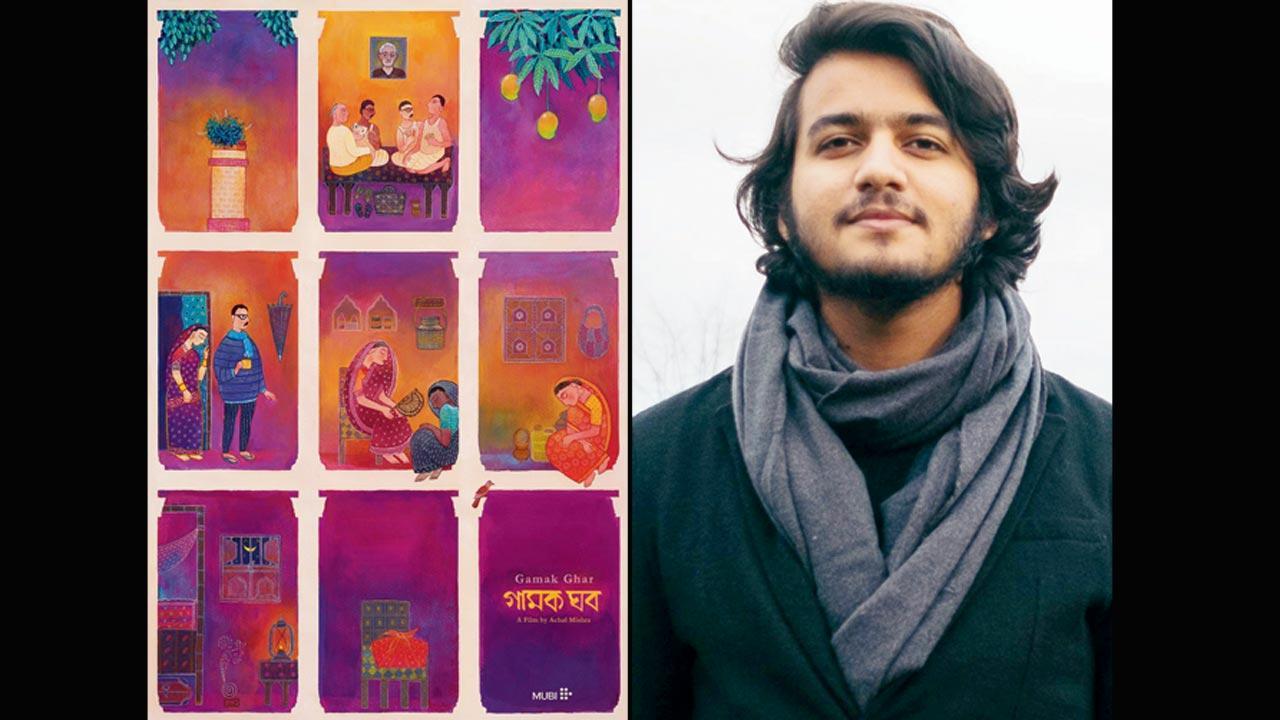How rare to find favourite film of the year that I literally wanna own, let alone recco/re-watch!

A poster of the film Gamak Ghar; (right) the film's director, Achal Mishra
Politician LK Advani, as is quite well known, used to be a film critic. I once heard him describe his first experience of watching Satyajit Ray's Pather Panchali that stays in memory. Halting at each word, he simply said, "Mera maatha aisa thanka (my mind frickin' boggled at the sight)!"
ADVERTISEMENT
I guess he was reacting to the sense of recognition, and debilitating realism of rural India/Bengal — from the boy Apu, old lady Indir Takrun, to the pastoral landscape — that was hitherto unseen, on screen, for most people in the world.
That's precisely how I felt the first time I clicked on Achal Mishra's Gamak Ghar (on Mubi), earlier in the year, literally pacing up and down, staring at the scenery on my phone, calling up family/relatives thereafter to download the app and revel in it themselves — right away; no, right now!
Except, this cinéma vérité (cinema of truth) experiment, without a formal protagonist, is a series of long mid-shots of the director's family home, captured over three timelines (1998, 2010, 2018), in a village called Madhopur, in Mithila. The actors are pretty much playing, or at any rate, speaking as they are. It is obviously nothing like Pather Panchali. Or is; if you consider the unique expanse it evocatively draws you into.
Where exactly is Mithila? Mythologically, where Sita was from. Hence her name, Maithili. Which is also the principal language in these parts. Geographically, it is in North Bihar, touching Nepal and Bengal. Achal's village is in the town Darbhanga, which is a corruption for Dwar Banga (or doorway to Bengal).
Maithili, which has a rhythmically sing-song tone, shares its original script with Bengali. Which explains that, say, Nagarjun, the great Hindi/Maithili poet of a more recent vintage, also wrote in Bangla; likewise, the Bengal stalwart Tagore/Gurudev, also composed poetry in Maithili.
Culturally, as I've known it all my life — since that's where I'm ancestrally from — it is a sleepy, agrarian stretch, with lives traditionally centred on simple things. Like a song, for every occasion.
And an insane love for food, on which life seems eternally centred — in particular the bhoj (feast), that involves maangsh (mutton) and maachh (the river fish, rahu), along with rasgulla, and endless eating competitions that ensue, where the anointed champions become legends forever!
I'm only providing contextual background. Achal's film gently takes us on a more visceral ride instead, with the opening still of earthen pots of dahi and stacks of mangoes in the corner. Daytime walks around gaachhi (mango orchards).
Soft-spoken relatives switching into Hindi/English for visiting urban kids in the village home. Ladies frying bachka/tarua (eggplant pakodas) for lunch, with sarcastic gentlemen playing cards at home (surely the popular game, 29), over countless cups of sweet, milky tea...
The home is the family heirloom. This is a specific universe cloaked into a universal film, about a kutumb (family) that Achal's grandfather would've put in place — through an image of whom, I could sense glimpses of my own (although I never got to see him).
It's also a world lightly held together by 'beedh-bidhaan' (rituals; like wedding, birth, thread ceremony, etc), and 'bhaiyyari' (relationship bonds), vanishing chiefly through neglect born out of inevitable migration/urbanisation.
The beauty of Achal's soft framing/touch is he never lets heaviness of a plot, or clichés of lament, get in the way of what connoisseurs of art will instantly classify as pure impressionism. A lot like Turner; both the painter, and the film! Madhubani painting, in fact, is what you're likely to be acquainted with about Mithila as a region. It's mildly referenced in the film's poster that I intend to put up on my wall.
For visual language/style, as it were, Achal — who dropped out of film theory/studies programme at King's College, London — says he was inspired by the Japanese master Ozu, and Taiwanese New Wave director Hou Hsiao-Hsien. Gamak Ghar premiered at MAMI film festival in 2019, subsequently travelling to Kolkata, Kerala, Delhi.
First thing people told Achal after the film, he tells me, is they'd never seen Bihar like this before. People from Tamil Nadu, Kerala conversely felt that they were actually looking at their own families/village back home. Achal is 24 years old.
I essentially called him to check if I can just buy Gamak Ghar off him! Forget recommend/re-watch, which as you can see, I already have; as per me, it's the best movie of 2020! Because real favourites inevitably emerge from childhood — most such lists otherwise are exercises in highbrow taste-signalling, or academic consensus — you can't beat nostalgia with intellect.
The first chapter of Achal's three-act movie is set in the '90s. It hit me in indescribable ways: Aisa maatha thanka, so to say! What I saw was somewhat my own ancestral home — full of distant and close relatives, many of whom are no more.
Given the lack of videos at the time, all I have is a VHS tape (on DVD) of them in the front courtyard at a family function, breaking into loud 'thahakas' (deafening guffaws), that Maithils take immense pride in. Outside of that, there is Gamak Ghar, an artefact for eternity. Gajab!
Mayank Shekhar attempts to make sense of mass culture. He tweets @mayankw14
Send your feedback to mailbag@mid-day.com
The views expressed in this column are the individual's and don't represent those of the paper
 Subscribe today by clicking the link and stay updated with the latest news!" Click here!
Subscribe today by clicking the link and stay updated with the latest news!" Click here!







